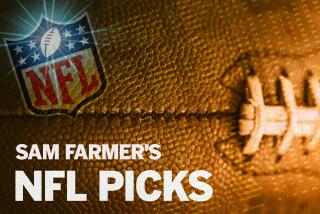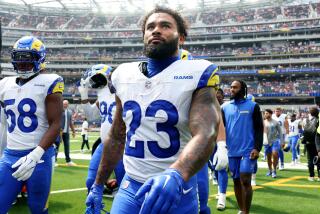Bears Rely On More Than Luck
For the football game of the week, the NFL is sending Brett Favre and the Green Bay Packers into Soldier Field today to find out whether their ancient Central Division rivals, the Chicago Bears, are better this year, or just luckier.
When both of them won last Sunday, the Bears joined the St. Louis Rams and Oakland Raiders as the league’s only 6-1 teams. The Pack is 5-2.
The whimsical thing about the Bears is that after the draft last spring, they fired the veteran personnel man who had built the team, Mark Hatley, who transferred immediately to Green Bay as vice president and chief scout.
As his last four gifts to the Bears, Hatley drafted two Michigan men 1-2--wide receiver David Terrell and running back Anthony Thomas--and imported a pair of 300-pound free agents, tackles Ted Washington and Keith Traylor, to solidify the defensive line.
These four, who could haunt Hatley’s new team today, have made the difference in a Bear lineup that is otherwise much the same as last year’s. Accordingly, this game, which is for first place in the NFC Central, could be known as the Hatley Bowl.
A Playoff Team
The new Bear attracting the most attention is running back Thomas, who gives quarterbacks Jim Miller and Shane Matthews the balanced attack that all pro clubs crave.
Still, Washington and Traylor have proved at least as helpful, moving their 600 defensive pounds around to free up middle linebacker Brian Urlacher for the stardom he seemed destined for at times last year in his rookie season
The result is that the Bears’ fast young defense, as recruited by Hatley, has kept them in every game, even the one they lost to Super Bowl champion Baltimore on opening day, 17-6. To a man, afterward, the Bears said they should have upset the Ravens.
Continuing their six-game winning streak last Sunday, the league’s longest, the Bears were widely described as lucky to get by Cleveland, 27-21, after the Browns had led in the fourth quarter, 21-7. But a close look at all 64 minutes of that overtime game suggests that maybe the Browns were lucky to stay in it.
The Bears led in possession time, 37 minutes 40 seconds to 25:10; in first downs, 29 to 12; in yards, 413 to 261--and in every other meaningful category--after the Browns had lucked into an early touchdown on a Chicago fumble.
From this distance, I’d say, first, that winning Coach Dick Jauron has a playoff team in Chicago, and, second, that new Coach Butch Davis is building an eventual champion in Cleveland.
Favre Outplayed
The best team in the NFC Central is probably Green Bay, win or lose at Soldier Field today. One obvious difference is that Green Bay’s Favre is more quarterback than Chicago’s Miller and Matthews, combined.
Even so, in a 21-20 game last Sunday, Favre was outplayed by Tampa Bay quarterback Brad Johnson until the last three minutes, when a Packer cornerback, Allen Rossum, won it with a fast 55-yard punt return.
Considering the quality of Favre, of running back Ahman Green, and of such receivers as Antonio Freeman and tight end Bubba Franks, among other Packers, the question is whether Executive Vice President/General Manager Coach Mike Sherman is getting the most out of what’s there.
As for Tampa Bay’s quarterback, Johnson may be the greatest statue who ever threw a football. No active passer has more accuracy. Nobody else has Johnson’s vision. Nobody is slower, less mobile, more lifeless.
The Buccaneers would be better than 3-4 in the standings if they only knew how to protect him. What he might need most is a nine-player pocket and one man out--say, Keyshawn Johnson. In that formation, I’d give odds that Johnson would connect with Johnson most every time, although he’d be triple-covered.
Steelers Trying
The two teams that have talked the most about opening up their conservative offenses lately are Tampa Bay and Pittsburgh--yet neither coaching staff seems to know precisely how to do it.
The Buccaneers’ coach, for example, defensive connoisseur Tony Dungy, spent the week in Tampa before the Green Bay game forecasting that his people would really “throw the ball up there this time.”
But a running team can’t instantly turn itself into a passing team. Plainly, NFL pass offense has to be intensively practiced and constantly reviewed from camp on.
At heart, the Buccaneers prefer to run the ball with Mike Alstott, although, in Green Bay, Alstott totaled only 30 yards in 17 carries. By comparison Johnson completed 18 passes for 130 yards.
At Pittsburgh, Bill Cowher seems to be actually trying to open up. He won a big game recently with a halfback pass by Jerome Bettis. And he had quarterback Kordell Stewart throwing on first down much of the time against Baltimore, though in the end the Steelers lost, 13-10, for a familiar NFL reason: Their kicker couldn’t kick straight.
Cowher’s more compelling problem is that, despite the best of intentions, he’d rather see Bettis run than Stewart throw.
Stewart Valuable
Stewart is a very good passer, perhaps as accurate as any in pro ball, and more powerful than many. He brings to passing the same high quality Jerome Bettis gives to running. Football, though, has both passing downs and running downs, and it’s hard for any NFL quarterback to complete a pass on a passing down--say, third and long. Nor is it easy for any NFL runner to run on a running down--say, first down--even though Bettis has had some success doing that.
Over the years, the Steelers have too often asked Stewart to pass on passing downs, and that accounts for much of his unimpressive record.
He and Bettis would both have more success with shrewder play selection by the coaches.
NFL Key: Play Selection
Of all NFL teams, Cowher’s Steelers would gain the most with a play-selection approach integrating their best passer and best runner. That’s because in the NFL today, there is nobody like Bettis, and there are few like Stewart.
The Steelers would confound every defense if, at the start of most plays, they threatened to run Bettis or throw with Stewart. They were going to beat the Ravens last Sunday if they hadn’t, alternately, left Bettis on his own, then Stewart on his own.
That day, nearly every Steeler play could more profitably have begun with a fake run or a fake pass--ending sometimes in draw plays and sometimes in play-action passes.
On the series that cost the Steelers the game, they shook Bettis loose for 35 yards to reach scoring position, then ran him twice more on simple ground plays before Stewart entered the picture on third and long to throw a pass he couldn’t complete against the Ravens’ stacked pass defense.
Then on fourth down, they blew another easy field goal. But it wasn’t the kicker who blew the game, it was the play selection on the preceding three downs.
Once Bettis had run them into scoring position, the Steelers could have thrown a quick pass on first down after faking a Bettis run. Or they could have done something like that on second down.
Or, on third and long, they could have run Bettis instead of hopelessly attempting a pass by a passer who, earlier in the game, on first-down plays, had seemed to be the reincarnation of Terry Bradshaw or Joe Montana.
It should be evident by now that in matchups involving the NFL’s better teams, play selection can be the decisive determinant.
More to Read
Go beyond the scoreboard
Get the latest on L.A.'s teams in the daily Sports Report newsletter.
You may occasionally receive promotional content from the Los Angeles Times.










